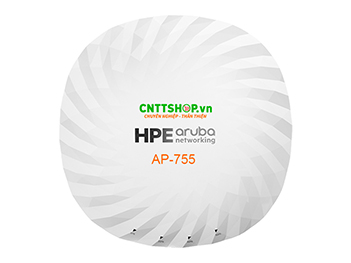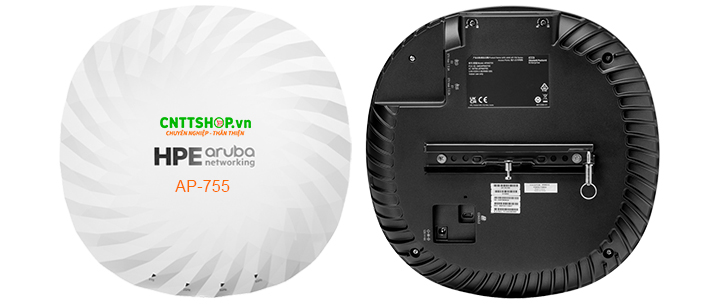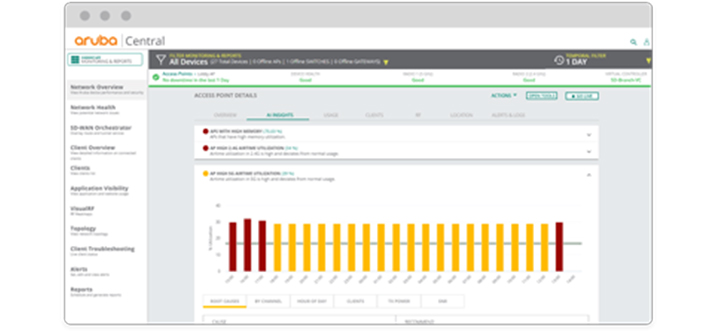|
• AP type: Indoor, tri radio, 2.4 GHz, 5 GHz and 6 GHz (concurrent) 802.11be 4x4 MIMO
• 2.4 GHz radio: Four spatial stream Single User (SU) MIMO for up to 1.4 Gbps wireless data rate with 4SS EHT40 802.11be client devices
• 5 GHz radio: Four spatial stream Single User (SU) MIMO for up to 5.8 Gbps wireless data rate with 2SS EHT160 802.11be client devices
• 6 GHz radio: Four spatial stream Single User (SU) MIMO for up to 11.5 Gbps wireless data rate with 2SS EHT320 802.11be client devices
• MU‑MIMO (downlink, uplink) is supported on all radios
• Up to 512 associated client devices per radio, and up to 16 BSSIDs per radio
• Supported frequency bands (country‑specific restrictions apply):
– 2.400 to 2.4835 GHz ISM
– 5.150 to 5.250 GHz U‑NII‑1
– 5.250 to 5.350 GHz U‑NII‑2
– 5.470 to 5.725 GHz U‑NII‑2E
– 5.725 to 5.850 GHz U‑NII‑3/ISM
– 5.850 to 5.895 GHz U‑NII‑4
– 5.925 to 6.425 GHz U‑NII‑5
– 6.425 to 6.525 GHz U‑NII‑62
– 6.525 to 6.875 GHz U‑NII‑7
– 6.875 to 7.125 GHz U‑NII‑8
• Available bands and channels: Dependent on configured regulatory domain (country) • Dynamic frequency selection (DFS) optimizes the use of available RF spectrum in the 5 GHz band
• Including Zero‑Wait DFS (ZWDFS) to accelerate channel changes
• Supported radio technologies:
–802.11b: Direct‑sequence spread‑spectrum (DSSS)
–802.11a/g/n/ac: Orthogonal frequency‑division multiplexing (OFDM)
–802.11ax/be: Orthogonal frequency‑division multiple access (OFDMA) with up to 37 resource units
• Supported modulation types:
– 802.11b: BPSK, QPSK, CCK–802.11a/g/n: BPSK, QPSK, 16‑QAM, 64‑QAM and 256‑QAM (proprietary extension)
– 802.11ac: BPSK, QPSK, 16‑QAM, 64‑QAM, 256‑QAM and 1024‑QAM (proprietary extension)
– 802.11ax: BPSK, QPSK, 16‑QAM, 64‑QAM, 256‑QAM, and 1024‑QAM
– 802.11be: BPSK, QPSK, 16‑QAM, 64‑QAM, 256‑QAM, 1024‑QAM, and 4096‑QAM
• 802.11n high throughput (HT) support: HT20/40
• 802.11ac very high throughput (VHT) support: VHT20/40/80/160
• 802.11ax high efficiency (HE) support: HE20/40/80/160
• 802.11be extreme high throughput (EHT) support: EHT20/40/80/160/320
• Supported data rates (Mbps):
– 802.11b: 1, 2, 5.5, 11
– 802.11a/g: 6, 9, 12, 18, 24, 36, 48, 54
– 802.11n: 6.5 to 600 (MCS0 to MCS15, HT20 to HT40)
– 802.11ac: 6.5 to 3,467 (MCS0 to MCS9, NSS = 1 to 4, VHT20 to VHT160)
– 802.11ax: 7.3 to 4,804 (MCS0 to MCS11, NSS = 1 to 4, HE20 to HE160)
– 802.11be: 7.3 to 11,530 (MCS0 to MCS13, NSS = 1 to 4, EHT20 to EHT320)
• 802.11n/ac packet aggregation: A‑MPDU, A‑MSDU
• Transmit power: Configurable in increments of 0.5 dBm
• Maximum (aggregate, conducted total) transmit power (limited by local regulatory requirements–Per radio/band (2.4 GHz/5 GHz/6 GHz): +24 dBm (18 dBm per chain)–Note: conducted transmit power levels exclude antenna gain. For total (EIRP) transmit power, add antenna gain.
• Advanced Cellular Coexistence (ACC) minimizes the impact of interference from cellular networks
• Ultra Tri‑Band (UTB) enables ultimate flexibility in 5 GHz and 6 GHz channel selection without performance degradation
• Maximum ratio combining (MRC) for improved receiver performance
• Cyclic delay/shift diversity (CDD/CSD) for improved downlink RF performance
• Space‑time block coding (STBC) for increased range and improved reception
• Low‑density parity check (LDPC) for high‑efficiency error correction and increased throughput
• Transmit beam‑forming (TxBF) for increased signal reliability and range
• 802.11ax Target Wait Time (TWT) to support low‑power client devices
• 802.11mc/az Fine Timing Measurement (FTM) for precision distance ranging
|
 Switch
Switch Wifi - Access Point
Wifi - Access Point Firewall
Firewall Router
Router Module Quang
Module Quang![Module Quang Cisco]() Module Quang Cisco
Module Quang Cisco![Module quang HPE]() Module quang HPE
Module quang HPE![Module quang Maipu]() Module quang Maipu
Module quang Maipu![Module quang Brocade]() Module quang Brocade
Module quang Brocade![Module quang Fortinet]() Module quang Fortinet
Module quang Fortinet![Module quang Aruba]() Module quang Aruba
Module quang Aruba![Module quang OEM]() Module quang OEM
Module quang OEM![Module quang Juniper]() Module quang Juniper
Module quang Juniper![Module quang Dell]() Module quang Dell
Module quang Dell![Module quang Palo Alto]() Module quang Palo Alto
Module quang Palo Alto![Module quang Huawei]() Module quang Huawei
Module quang Huawei![Module quang Arista]() Module quang Arista
Module quang Arista![Module quang F5]() Module quang F5
Module quang F5![Module quang H3C]() Module quang H3C
Module quang H3C![Module Quang Allied Telesis]() Module Quang Allied Telesis
Module Quang Allied Telesis![Module quang SonicWall]() Module quang SonicWall
Module quang SonicWall![Module quang Mikrotik]() Module quang Mikrotik
Module quang Mikrotik![Module quang Handar]() Module quang Handar
Module quang Handar Máy chủ (Server)
Máy chủ (Server) Thiết bị lưu trữ (SAN, NAS)
Thiết bị lưu trữ (SAN, NAS) Load Balancing
Load Balancing Video Conferencing
Video Conferencing Phụ kiện máy chủ
Phụ kiện máy chủ Thiết Bị IoT
Thiết Bị IoT Phụ Kiện Mạng
Phụ Kiện Mạng




.png)



























Bạn đang cần tư vấn về sản phẩm: S1G84A ?